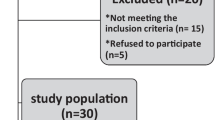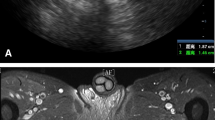Abstract
Purpose
The aim of this study was to evaluate the accuracy of tridimensional endoanal ultrasound (3D-EAUS) in the diagnosis of perianal sepsis comparing the results with the surgical findings, considered as reference standard.
Methods
From January 2009 to January 2013, all the patients referred for the assessment and treatment of perianal sepsis with suspected anorectal origin were enrolled in the study. All patients gave informed written consent. Prior to surgery, all the patients underwent anamnestic evaluation, clinical examination, and unenhanced and H2O2-enhanced 3D-EAUS. Surgery was performed by a colorectal surgeon blinded to the 3D-EAUS results.
Results
A total of 212 patients with suspected perianal suppurations were assessed during the study period. In 12 patients, the H2O2-enhanced 3D-EAUS was not performed, and so, they were excluded from the study. Very good agreement between 3D-EAUS and examination under anesthesia (EUA) in the classification of primary fistula tracts (kappa = 0.93) and in the identification of fistula internal opening (kappa = 0.97) was found. There was a good concordance (kappa = 0.71) between 3D-EAUS and surgery in the detection of fistula secondary extensions. The overall sensitivity and specificity of 3D-EAUS in the diagnosis of perianal sepsis were 98.3 and 91.3 % respectively.
Conclusion
3D-EAUS is a safe and reliable technique in the assessment of perianal sepsis. It may assist the surgeon in delineating the fistula tract anatomy and in determining the origin of sepsis, supporting the preoperative planning of definitive and appropriate surgical therapy.




Similar content being viewed by others
References
Rottenberg GT, Williams AB (2002) Endoanal ultrasound. Br J Radiol 75(893):482–8. doi:10.1259/bjr.75.893.750482
Deen KI, Williams JG, Hutchinson R, Keighley MR, Kumar D (1994) Fistulas in ano: endoanal ultrasonographic assessment assists decision making for surgery. Gut 35(3):391–4
Brunese L, Amitrano M, Gargano V, Vallone G, Grassi R, Rotondo A, Smaltino F (1996) [Anal endosonography: the study technic and the correlations between the normal and echographic anatomy] Radiol Med 91(3):253–7
Marano I, Grassi R, Donnianni T, Gargano V, Fanucci A, Romano G, Pellecchia L, Rotondano G (1996) CT and anal endosonography in the evaluation of electrically stimulated neoanal sphincter: a preliminary report. Abdom Imaging 21(4):353–6
Brunese L, Amitrano M, Gargano V, Pinto A, Vallone G, Grassi R, Rotondo A, Smaltino F (1996) [Role of anal endosonography in inflammation and trauma of the anal canal] Radiol Med 92(6):742–7
Grassi R, Rotondo A, Catalano O, Amitrano M, Vallone G, Gargano V, Fanucci A (1995) [Endoanal ultrasonography, defecography, and enema of the colon in the radiologic study of incontinence] Radiol Med 89(6):792–7
Kim Y, Park YJ (2009) Three-dimensional endoanal ultrasonographic assessment of an anal fistula with and without H(2)O(2) enhancement. World J Gastroenterol 15(38):4810–5
Reginelli A, Mandato Y, Cavaliere C, Pizza NL, Russo A, Cappabianca S, Brunese L, Rotondo A, Grassi R (2012) Three-dimensional anal endosonography in depicting anal-canal anatomy. Radiol Med 117(5):759–71. doi:10.1007/s11547-011-0768-4
Buchanan GN, Halligan S, Bartram CI, Williams AB, Tarroni D, Cohen CR (2004) Clinical examination, endosonography, and MR imaging in preoperative assessment of fistula in ano: comparison with outcome-based reference standard. Radiology 233(3):674–81. doi:10.1148/radiol.2333031724
Halligan S, Stoker J (2006) Imaging of fistula in ano. Radiology 239(1):18–33. doi:10.1148/radiol.2391041043
Cho DY (1999) Endosonographic criteria for an internal opening of fistula-in-ano. Dis Colon Rectum 42(4):515–8
Parks AG, Gordon PH, Hardcastle JD (1976) A classification of fistula in ano. Br J Surg 63(1):1–12
Williams JG, Farrands PA, Williams AB, Taylor BA, Lunniss PJ, Sagar PM, Varma JS, George BD (2007) The treatment of anal fistula: ACPGBI position statement. Colorectal Dis 9(Suppl 4):18–50. doi:10.1111/j.1463-1318.2007.01372.x
Ratto C, Grillo E, Parello A, Costamagna G, Doglietto GB (2005) Endoanal ultrasound-guided surgery for anal fistula. Endoscopy 37(8):722–8. doi:10.1055/s-2005-870155
Abou-Zeid AA (2011) Anal fistula: intraoperative difficulties and unexpected findings. World J Gastroenterol 17(28):3272–6. doi:10.3748/wjg.v17.i28.3272
Murad-Regadas SM, Regadas FS, Rodrigues LV, Holanda Ede C, Barreto RG, Oliveira L (2010) The role of 3-dimensional anorectal ultrasonography in the assessment of anterior transsphincteric fistula. Dis Colon Rectum 53(7):1035–40. doi:10.1007/DCR.0b013e3181dce163
Garcés-Albir M, García-Botello SA, Esclapez-Valero P, Sanahuja-Santafé A, Raga-Vázquez J, Espi-Macías A, Ortega-Serrano J (2012) Quantifying the extent of fistulotomy. How much sphincter can we safely divide? A three-dimensional endosonographic study. Int J Colorectal Dis 27(8):1109–16. doi:10.1007/s00384-012-1437-3, Epub 2012 Mar 16
Murad-Regadas SM, Regadas FS, Rodrigues LV, Fernandes GO, Buchen G, Kenmoti VT, Soares Gdos S, Holanda EC (2011) Anatomic characteristics of anal fistula on three-dimensional anorectal ultrasonography. Dis Colon Rectum 54(4):460–6. doi:10.1007/DCR.0b013e3182060c84
Subasinghe D, Samarasekera DN (2010) Comparison of preoperative endoanal ultrasonography with intraoperative findings for fistula in ano. World J Surg 34(5):1123–7. doi:10.1007/s00268-010-0478-4
Santoro GA, Fortling B (2007) The advantages of volume rendering in three-dimensional endosonography of the anorectum. Dis Colon Rectum 50(3):359–68. doi:10.1007/s10350-006-0767-z
Tilney HS, Heriot AG, Trickett JP, Massouh H, Edwards DP, Mellor SG Gudgeon AM (2006) The use of intra-operative endo-anal ultrasound in perianal disease. Colorectal Dis 8(4):338–41. doi:10.1111/j.1463-1318.2006.00927.x
Felt-Bersma RJ (2006) Endoanal ultrasound in perianal fistulas and abscesses. Dig Liver Dis 38(8):537–43. doi:10.1016/j.dld.2006.02.016
Lengyel AJ, Hurst NG, Williams JG (2002) Pre-operative assessment of anal fistulas using endoanal ultrasound. Colorectal Dis 4(6):436–40
Moscowitz I, Baig MK, Nogueras JJ, Ovalioglu E, Weiss EG, Singh JJ, Wexner SD (2003) Accuracy of hydrogen peroxide enhanced endoanal ultrasonography in assessment of the internal opening of an anal fistula complex. Tech Coloproctol 7(3):133–7. doi:10.1007/s10151-003-0024-6
Ratto C, Gentile E, Merico M, Spinazzola C, Mangini G, Sofo L, Doglietto G (2000) How can the assessment of fistula-in-ano be improved? Dis Colon Rectum 43(10):1375–82
Siddiqui MR, Ashrafian H, Tozer P, Daulatzai N, Burling D, Hart A, Athanasiou T (2012) Phillips RK A diagnostic accuracy meta-analysis of endoanal ultrasound and MRI for perianal fistula assessment. Dis Colon Rectum 55(5):576–85. doi:10.1097/DCR.0b013e318249d26c
Sun MR, Smith MP, Kane RA (2008) Current techniques in imaging of fistula in ano: three-dimensional endoanal ultrasound and magnetic resonance imaging. Semin Ultrasound CT MR 29(6):454–71
West RL, Dwarkasing S, Felt-Bersma RJ, Schouten WR, Hop WC, Hussain SM, Kuipers EJ (2004) Hydrogen peroxide-enhanced three-dimensional endoanal ultrasonography and endoanal magnetic resonance imaging in evaluating perianal fistulas: agreement and patient preference. Eur J Gastroenterol Hepatol 16(12):1319–24
West RL, Zimmerman DD, Dwarkasing S, Hussain SM, Hop WC, Schouten WR, Kuipers EJ, Felt-Bersma RJ (2003) Prospective comparison of hydrogen peroxide-enhanced three-dimensional endoanal ultrasonography and endoanal magnetic resonance imaging of perianal fistulas. Dis Colon Rectum 46(10):1407–15. doi:10.1097/01.DCR.0000089112.99927.60
Gustafsson UM, Kahvecioglu B, Aström G, Ahlström H, Graf W (2001) Endoanal ultrasound or magnetic resonance imaging for preoperative assessment of anal fistula: a comparative study. Colorectal Dis 3(3):189–97
Sabir N, Sungurtekin U, Erdem E, Nessar M (2000) Magnetic resonance imaging with rectal Gd-DTPA: new tool for the diagnosis of perianal fistula. Int J Colorectal Dis 15(5–6):317–22
Scholefield JH, Berry DP, Armitage NC, Wastie ML (1997) Magnetic resonance imaging in the management of fistula in ano. Int J Colorectal Dis 12(5):276–9
Solomon MJ (1996) Fistulae and abscesses in symptomatic perianal Crohn’s disease. Int J Colorectal Dis 11(5):222–6
Faggian A, Muto M, Pizza NL, Iasiello F, Iacobellis F, Berritto D, Gatta G, DI Grezia G, Serra N, Grassi R (2014) [Role of three dimensional endoanal ultrasound and MRI in the assessment of perianal fistulas] Il giornale italiano di Radiologia Medica 1:955–960
Author information
Authors and Affiliations
Corresponding author
Additional information
Antonio Brillantino and Francesca Iacobellis contributed equally to this work.
Rights and permissions
About this article
Cite this article
Brillantino, A., Iacobellis, F., Di Sarno, G. et al. Role of tridimensional endoanal ultrasound (3D-EAUS) in the preoperative assessment of perianal sepsis. Int J Colorectal Dis 30, 535–542 (2015). https://doi.org/10.1007/s00384-015-2167-0
Accepted:
Published:
Issue Date:
DOI: https://doi.org/10.1007/s00384-015-2167-0




